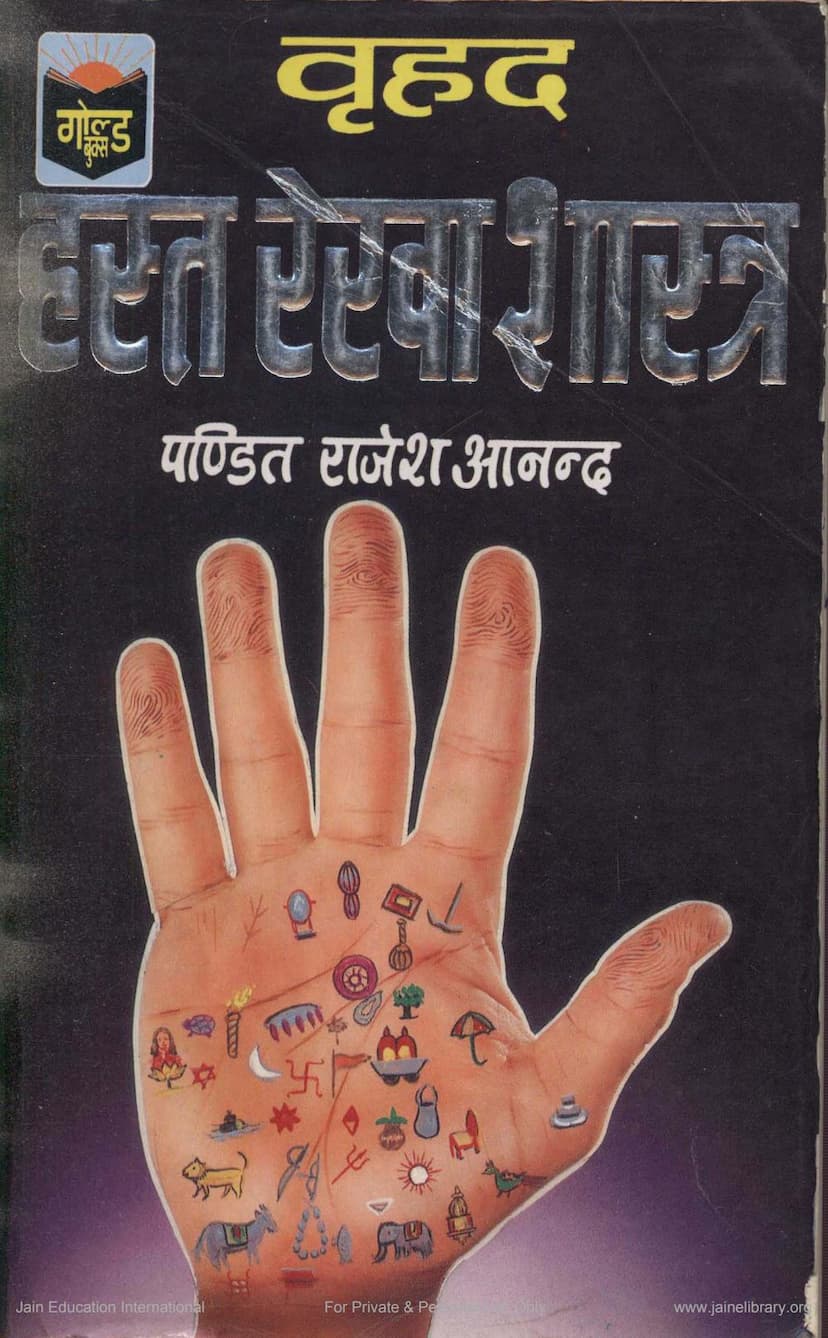Vruhad Hast Rekha Shastra
Added to library: September 2, 2025

Summary
Here's a comprehensive summary of the Jain text "Vruhad Hast Rekha Shastra" by Rajesh Anand, based on the provided pages:
Book Title: Vruhad Hast Rekha Shastra (Great Palmistry) Author: Pandit Rajesh Anand Publisher: Gold Books (India), Delhi Catalog Link: https://jainqq.org/explore/001758/1
Overall Purpose and Introduction: "Vruhad Hast Rekha Shastra" is presented as an invaluable and rare text that serves as a mirror to a person's past, present, and future through the lines on their hands. The book aims to provide insights into a person's character, mental state, physical health, marital life, career, progeny, and the auspicious or inauspicious events, as well as their financial status (prosperity or poverty). It emphasizes that the lines on the hand are not static but can change with one's actions and efforts, offering individuals the power to alter their destiny. The author stresses the importance of careful reading, attention, and concentration to understand the book's contents.
Key Themes and Content:
- Palmistry as a Science: The book establishes palmistry as an ancient and significant discipline, linking it to Vedic traditions and even mentioning its use by celestial sages. It asserts that palmistry, along with other divinatory arts like astrology, astrology of the body, thumb reading, ramal, omens, and breath control, aims for human welfare.
- Detailed Analysis of the Hand: The text provides an extensive breakdown of hand analysis, covering:
- Hand Shape and Types: It categorizes hands into seven primary types (Square, Spatula-shaped, Conical, Opposite Conical, Small, Broad and Wide, Thin) and explains that the interpretation of lines can vary based on the hand's overall shape.
- Fingers: Detailed descriptions of the significance of the length, straightness, thickness, and flexibility of each finger, relating them to specific mounts and characteristics.
- Thumb: Analysis of the thumb's size, shape, flexibility, and its relation to willpower, logic, and love.
- Mounts (Graha): Explanation of the various mounts on the palm (Jupiter, Saturn, Sun, Mercury, Moon, Mars, Venus) and their influence on different aspects of life. The book notes that the prominence and shape of these mounts are crucial.
- Lines: The text is structured to extensively cover major and minor lines:
- Life Line: Its formation, start, end points (towards Mounts of Moon or Venus), shape (straight, curved, broken, chained, islands), branches, and significance for health, vitality, and life events.
- Head Line (Mastic Rekha): Its clarity, depth, breaks, islands, branches, and how it reflects mental faculties, intellect, and thinking patterns.
- Heart Line (Hriday Rekha): Its clarity, breaks, islands, branches, and how it signifies emotional state, relationships, and cardiac health.
- Fate Line (Bhagya Rekha): Its origin, course, breaks, islands, and its connection to career, destiny, and financial success.
- Other Lines: The table of contents indicates coverage of lines like Health Line, Fate Line (special), Intuition Line, Mercury Line, Mars Line, Rahu Line, Fish Symbol (Matsya), Marriage Lines, Desire Line (Brahma Rekha), Venus Lines, Moon Lines, Sun Lines, and Luxury Lines.
- Nails: Analysis of the color, length, shape, and markings on the nails, linking them to health and character.
- Markings: Detailed explanations of various markings like crosses, grids, spots, squares, triangles, stars, and moles on the palm and their auspicious or inauspicious meanings.
- Colors of the Hand: The book discusses hand colors (Pink, Yellow, Red, Blue, Deep Red/Black, Spotted, Cold, Hot, Empty) and their implications for personality and health.
- Numerology and Years: The text briefly touches upon calculating years on the fingers and palm.
- Planetary Influences: It outlines the brief descriptions of planets and their independent years of influence.
- Ethical Considerations for Palmists: The author highlights the importance of ethical conduct, restraint, and accuracy for palmists to prevent the misuse of this knowledge.
Key Principles Emphasized:
- Holistic Approach: The book stresses that a single line or mark is not sufficient for interpretation. A comprehensive analysis considers the hand's shape, finger proportions, mounts, all lines, markings, and even the color and texture of the hand.
- Balance of Good and Bad: The text acknowledges that most hands possess a combination of positive and negative indications, and the overall life experience is a result of these influences and the individual's actions.
- Changeable Destiny: A core message is that while palmistry reveals potentials and predispositions, one's own efforts, karma, and willpower can influence and change their destiny.
Target Audience: The book is intended for anyone who wishes to understand themselves and others better, gain insight into their future, and potentially improve their life through self-awareness and proactive effort. It is particularly useful for aspiring palmists and those interested in self-improvement.
Overall Impression: "Vruhad Hast Rekha Shastra" appears to be a comprehensive and detailed guide to palmistry, offering a systematic approach to analyzing the hand. It aims to be both informative and empowering, encouraging readers to understand their potential and take control of their lives. The inclusion of numerous illustrations (mentioned as "hundreds of hand line diagrams") would be crucial for practical application.